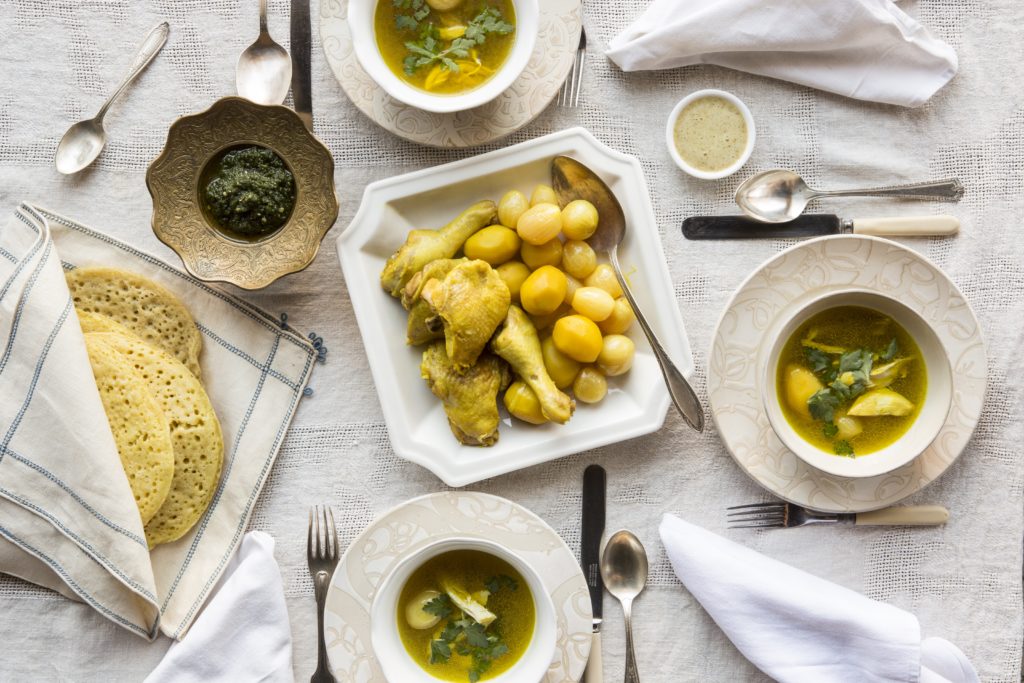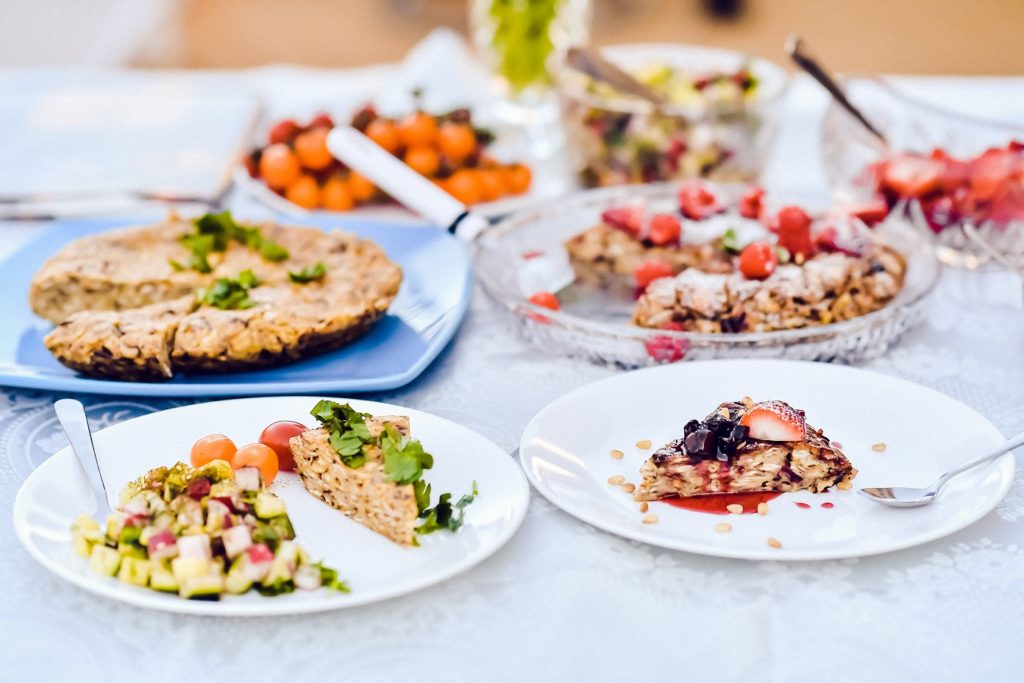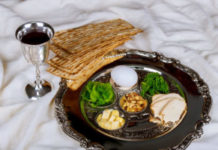Every year at Passover, families rejoice in reenacting both religious and cultural tradition — reading from the worn family Haggadah, using the seder plate Bubbe and Zayde got for their wedding, searching for the afikomen even though all the kids know Uncle Jason always puts it in the same place.
While we can easily make assumptions about what our own seders will be like, the worldwide Jewish experience is varied and colorful, and customs — especially when it comes to food — can diverge and surprise.
This year, given that Passover is already unusual due to the pandemic, we thought we’d talk to Jews from disparate backgrounds and hear about what Passover means to them. Unsurprisingly, most people talked a lot about food — a passion for eating is apparently the one thing all Jews have in common.
Enjoy the sampler and accompanying recipes — and get some ideas to try next week!
— Liz Spikol
Yemen: Chicken Soup for the Soul

When Ronen Koresh was growing up in Israel, gathering for the Passover seder with his extended Yemenite Jewish family was an exciting occasion.
“We would get together at my grandparents’ and family would join in from everywhere, and it was huge,” the choreographer and owner of Koresh Dance Co. in Rittenhouse Square said.
His grandparents followed traditions closely, from reclining on pillows throughout the meal to making sure the Haggadah was read in its entirety.
It was a long time for a small boy to wait for the festive meal, but it was worth it when his relatives brought out the food. In addition to symbolic Passover dishes like matzah, Yemenite soup was a seder table staple.
“A soup, in the Yemenite tradition, is pretty much a full meal,” Koresh said. “It’s either beef or chicken, and primarily what makes it so special is the spices.”
His mother and grandmother cooked the dish with hawaij, a blend of ground spices including black pepper, cumin, turmeric and saffron.
“So back then, actually, for my mom and my grandmother, and the family members who cooked, everything was made by hand,” he said. “So they were crushing spice, they had a special rock and they blended it themselves.”
Yemenite soup is usually served with flatbread, but diners crumble matzah into the broth during Passover.
— Sophie Panzer
Yemenite Chicken Soup
Serves 4
1 whole chicken
(about 4 pounds)
Kosher salt
1 tablespoon plus 2 teaspoons hawaij, plus more for serving
2 tablespoons olive oil
1 onion, sliced
4 garlic cloves, sliced
2 quarts chicken stock
12 baby Yukon Gold potatoes, peeled
1 bunch ramps or scallions, sliced
Slice the chicken breasts from the bone and discard the skin; reserve the bones. Season the breast meat generously on both sides with salt and 1 teaspoon of the hawaij, put it on a plate, and refrigerate. Remove the drumsticks, thighs and wings from the carcass.
Warm the oil in a large pot over medium heat. Add the onion, garlic and a pinch of salt and cook, stirring frequently, until the onion begins to soften, about 10 minutes. Add the chicken stock and the chicken pieces (except for the reserved breast meat), breast bones and carcass. Raise the heat to medium-high and bring it to a boil, skimming off any foam that rises to the surface.
Lower the heat to a simmer and add 1 tablespoon of the hawaij. Simmer for about 45 minutes, until the chicken is cooked through.
Transfer the thighs and drumsticks to a plate, cover and refrigerate. Simmer the soup for another 2 hours.
Pour the soup through a fine mesh strainer into a clean soup pot; discard the solids. Place the pot over medium heat and add the reserved chicken thighs and drumsticks, along with the potatoes and the remaining teaspoon of hawaij. Bring it to a simmer and cook until the potatoes are tender, about 20 minutes.
Add the reserved chicken breasts and ramps or scallions and simmer until the chicken is just cooked through, about 10 minutes more. Remove the chicken breasts from the soup and gently pull the meat apart using two forks. Season the broth with salt and more hawaij if you like.
To serve, transfer the chicken thighs and drumsticks and potatoes to a platter. Divide the shredded chicken and ramps or scallions among four soup bowls, ladle in the broth and serve with the platter of chicken and potatoes.
Yemenite Chicken Soup from Zahav, © 2015 by Michael Solomonov and Steven Cook. Reproduced by permission of Rux Martin Books/Houghton Mifflin Harcourt. All rights reserved.
Preserving Moroccan Traditions
For years, Abraham Azagury’s family read the Haggadah in Ladino, a language influenced by Spanish, Hebrew, Greek and Turkish. Next week, Azagury, a resident of Pittsburgh’s Squirrel Hill neighborhood, will continue that family tradition — along with some adaptations his father instituted decades ago.
“My father’s parents, who were from Morocco, would read the entire Haggadah in Ladino,” Azagury said. But when Azagury was a child, his father would mix in English as well, to keep the kids interested.
Now that he’s a father, he’s finding ways to honor his Moroccan heritage and pass it on to his children. In addition to reciting “Mah Nishtana” and “Ha Lachma Anya” in Ladino, and telling the story of the Exodus, at the evening’s start Azagury will lift the seder plate above each person’s head and say, “Bibhilu yatzanu mi–mizrayim” (“in haste we went out from Egypt”).
Later, when recalling the 10 plagues, Azagury will mention each plague in Ladino, then pour wine into a bucket while his wife and children pour water into the same container. After 10 spills of wine and 10 spills of water, they’ll dump the liquid into the toilet, thereby discarding the negative association of the wine-water combination.
Azagury said he understands that customs should reflect not just history, but also the present. One of his father’s traditions, which is followed by some Moroccans, is avoiding fish and chicken throughout the holiday because those animals consume grain (chametz).
Azagury’s practice of avoiding fish and chicken ended the day he got married: “My wife said, ‘We’re not only eating potatoes on Pesach.’”
— Adam Reinherz
A Dish That Survived Oppression in the Soviet Union

Polina Mirskiy’s early Passover memories are of smuggling matzah.
In communist Moldova, a country that had been part of the Soviet Union when Mirskiy was a child, Jews weren’t allowed to practice their religion. She and her family would quietly celebrate a version of the holiday. They didn’t have elaborate seders complete with rituals, but they would have a special dinner with her grandparents, and they would have matzah.
“Everything was hidden,” said Mirskiy, owner of Amber Room Day Spa in Pikesville, Maryland. “It was everything quietly, but overall, that matzah — we all remember crunching it and having it there.”
Mirskiy’s father would bring flour to a synagogue in Kishinev, the capital of Moldova, where they would bake matzah. They would pile boxes of it into their car and drive six hours to Ukraine, where Mirskiy’s paternal grandparents lived.
Her grandmother would do a lot of cooking with the matzah. One of her recipes was matzah babka, an Eastern European dish similar to matzah brei.
It’s a dish Mirskiy still makes for Passover, which she now celebrates with her family in Owings Mills, Maryland. She lives with her husband, Denis, whose family is from Belarus, and their three children, who are students at a Jewish day school. The children lead the family seder and teach her and her husband the Passover traditions, and she brings her family’s recipes.
“It brings the generations together,” Mirskiy said.
Here are two of Mirskiy’s recipes for matzah babka, one savory and one sweet.
— Selah Maya Zighelboim

Matzah Babka (savory)
8 pieces of matzah, broken into quarter-size pieces
4 extra-large eggs, cracked separately, one by one to check for blood spots
2 cups hot water
1 tablespoon kosher salt
¼ teaspoon ground black pepper
¼ teaspoon sweet paprika
¼ teaspoon sugar
¼ cup neutral oil
Optional: 1 medium onion, chopped and sauteed until golden brown
Break the matzah into a large bowl, and pour the hot water on it. Let it soak for 2 minutes.
While the matzah is soaking, break and whisk the eggs in a separate bowl.
Add the salt, pepper and sauteed onions to the egg mixture. Mix and add it to the matzah and water bowl. Mix everything with a spatula.
Preheat a medium-size skillet (10 inches), add the oil and gradually add the matzah/egg mixture. Flatten the mixture with the spatula so it is even. Let it brown on one side on medium heat for about 5-7 minutes.
Oil a large plate or flat skillet lid that is a little larger than the skillet that you are using and cover the skillet with it. Quickly flip the babka on the platter and slide it back carefully onto the skillet again. You should have a nice crust on top.
Lower the heat and cover it with a lid for additional 5-7 minutes, until the eggs cook through.
Slide the cooked babka on a serving platter. Let it cool for a few minutes, slice it into triangles and serve warm or cold.
We serve this with a fresh cucumber, radish, green onion and chopped dill salad. It can be served with dairy, parve or meat dishes.
Sour Cherry Matzah Babka (sweet)
8 pieces of matzah, broken into quarter-size pieces.
2 cups hot water
4 extra-large eggs, cracked separately, one by one to check for blood spots
¼ cup oil
½ teaspoon vanilla
Optional: ½ teaspoon cinnamon
½ cup sour cherry preserves (can be substituted for any fruit preserves or honey)
Optional: ½ cup pine nuts or chopped nuts of choice (for best flavor, heat up the nuts on a small skillet without oil, constantly mixing for a few minutes and being careful not to burn them)
2-3 tablespoons sugar
¼ teaspoon salt
Powdered sugar and more of the preserves for topping
Break the matzah into a large bowl and pour the hot water on it. Let it soak for two minutes.
While the matzah is soaking, break and whisk the eggs in a separate bowl.
Add the sugar, cinnamon, vanilla, preserves, pine nuts and salt into the egg mixture. Mix everything with a spatula.
Preheat a medium-size skillet (10 inches), add the oil and gradually add the matzah/egg mixture. Flatten the mixture with the spatula to be even. Let it brown on one side on medium heat for about 5-7 minutes.
Oil a large plate or flat skillet lid that is a little larger than the skillet that you are using and cover the skillet with it. Quickly flip the babka on the platter and slide back carefully onto the skillet again. You should have a nice crust on top.
Lower the heat and cover it with a lid for additional 5-7 minutes, until the eggs cook through.
Slide the cooked babka on a serving platter. Let it cool for a few minutes, slice it into triangles, drizzle with some more of the cherry preserves, sprinkle some powdered sugar and more of the nuts and enjoy.
We serve it warm or cold with a side of fresh berries. It tastes delicious with honey as well.
Brazilian-style Baking for Passover
 Describing herself as Afro-Latina, Brazilian and Jewish, LT Ladino Bryson (left) of Tempe, Arizona, values her heritage and wants to ensure that her sons do too.
Describing herself as Afro-Latina, Brazilian and Jewish, LT Ladino Bryson (left) of Tempe, Arizona, values her heritage and wants to ensure that her sons do too.
“Continuity is so important,” she said. “You learn from your past and create your own traditions to pass down. But I want them to understand their legacy, and it’s a fight to do that.”
Her sons, both 6-foot-4 and Black, “are going to be different no matter where they go,” she said. Anything she can do to help them “stay close to their roots and feel special about it,” is worthwhile.
And Passover represents the perfect time to reflect on the past and connect with family traditions. Just smelling the pão de queijo, cheese puff balls and Brazilian Passover cake invokes memories of family seders.
Bryson remembers the first time her family shared a seder with an Ashkenazi family where chicken was served. Growing up Sephardic, her sons had never experienced a seder meal without roast lamb. They were not fans, she said, and feels pretty confident that once they’re married with families of their own, lamb will remain a staple. But it’s the specifically Brazilian favorites she hopes they’ll keep baking, always remembering, “Mama did it best.”
Brazilians have it a little easier during the holiday when it comes to baking, she said.
Yuca flour is common in Brazil given that it comes from the storage roots of the cassava plant, a native species. Pão de queijo is light and fluffy — “this round golden goodness,” she said. “It is so light and crisps so well.” Brazilians love to incorporate fruit into desserts, and she advises choosing a few favorites to add to the cake recipe.
Both recipes here are fast, simple and quintessentially Brazilian.
— Shannon Levitt
Pão de Queijo (Cheese Puffs)
3 eggs
1½ cups oil
1½ cups milk
3 cups tapioca flour
(Yuca flour)
2 cups grated Parmesan, cheddar and/or mozzarella cheese
1 teaspoon salt or to taste
Preheat oven to 400 degrees F.
Mix all ingredients with a blender or food processor until smooth. The resulting batter should be sticky.
Use a tablespoon to separate the dough and roll it into balls. Put them into baking cups or a muffin tin.
Bake for 15-20 minutes or until the balls become puffy and just lightly browned.
Remove it from the oven and let it cool before removing them from the tin and eating.
Serve during the seder and at any time during Passover.
Brazilian Passover Cake
¼ cup matzah cake meal
1 teaspoon cream of tartar
½ teaspoon baking soda
¼ teaspoon salt
¼ cup butter, softened
1 cup white sugar
1 banana, mashed
1 apple (substitute for a favorite fruit if desired)
1 tablespoon grated orange zest from 1-2 oranges
1 egg
½ cup milk
⅓ cup brown sugar
2 tablespoons ground cinnamon
Preheat your oven to 350 degrees F and grease an 8-inch square baking pan with butter.
Sift the matzah cake meal, cream of tartar, baking soda, lemon zest and salt together in a large bowl.
Beat the butter in a large bowl with an electric mixer until creamy.
Add the white sugar gradually, beating until the butter is fluffy. Beat in the mashed banana and apples and egg.
Add the matzah meal mixture in three batches, alternating with milk, beating the batter briefly after each addition.
Spread the batter in the prepared cake pan and sprinkle brown sugar and cinnamon on top.
Bake for 30 minutes. Make sure a toothpick is clean when you check the middle.
What Makes a Persian Passover?
Meticulous cleaning is one of the hallmarks of a Persian Passover, said Ellie Dayan, who left Iran in 1996.
Judaism’s spring holiday almost always coincides with the Iranian secular new year, Nowruz. So Jews, in their quest to remove the leaven from their homes, kicked up the cleaning up a notch to match the intensity of their Muslim neighbors.
As for baking, “In Iran, we didn’t have kosher bakeries,” Dayan said. So Jews baked traditional holiday cookies that they took with them on visits to relatives and friends during Passover. Those cookies were “the smell of Passover,” Dayan said.
When it came to charoset, “each city had its own flavor,” Dayan explained. Her mother’s Tehran charoset combines pomegranate juice, walnuts, pistachios, grape juice and wine. Her father’s side of the family uses Kurdish sesame seed paste. And her husband’s family, originally from southern Iran, incorporates date nectar, paste or juice, which Dayan said she’s also seen used in Iraqi charoset.
A Persian seder also includes scallions, which come out with “Dayenu.”
“Everybody starts to hit each other with spring onions. I haven’t seen a Persian house that doesn’t do it,” Dayan said, adding that it’s OK to use lettuce instead. “It’s very joyful.” Children look forward to it. “On Rosh Hashanah, kids come up and ask if it’s time to do it.”
Some things have changed in America, she said. The cleaning is less fastidious, which Dayan can live with.
“You’d rather spend your energy on celebrating,” she said.
— David Holzel






